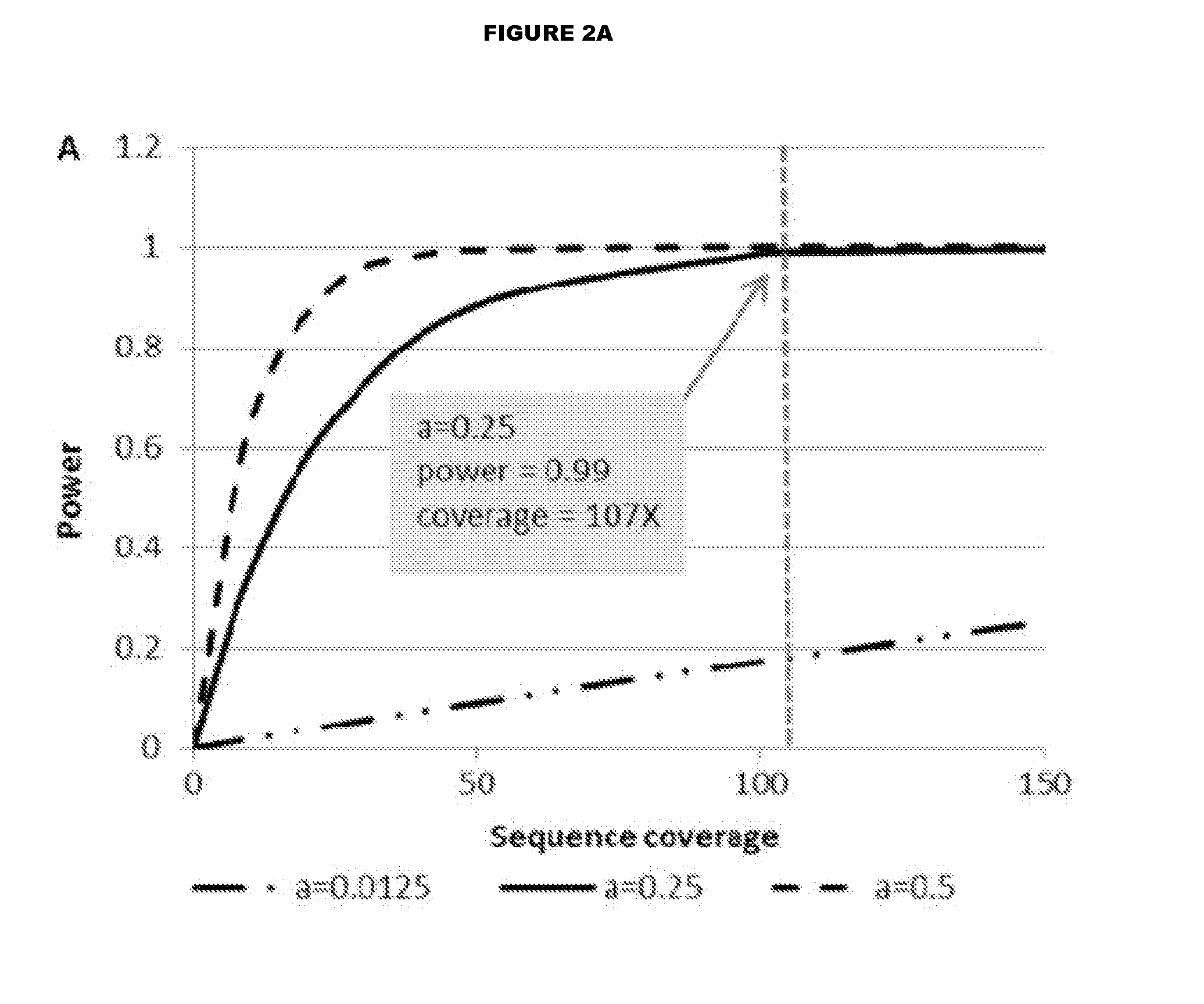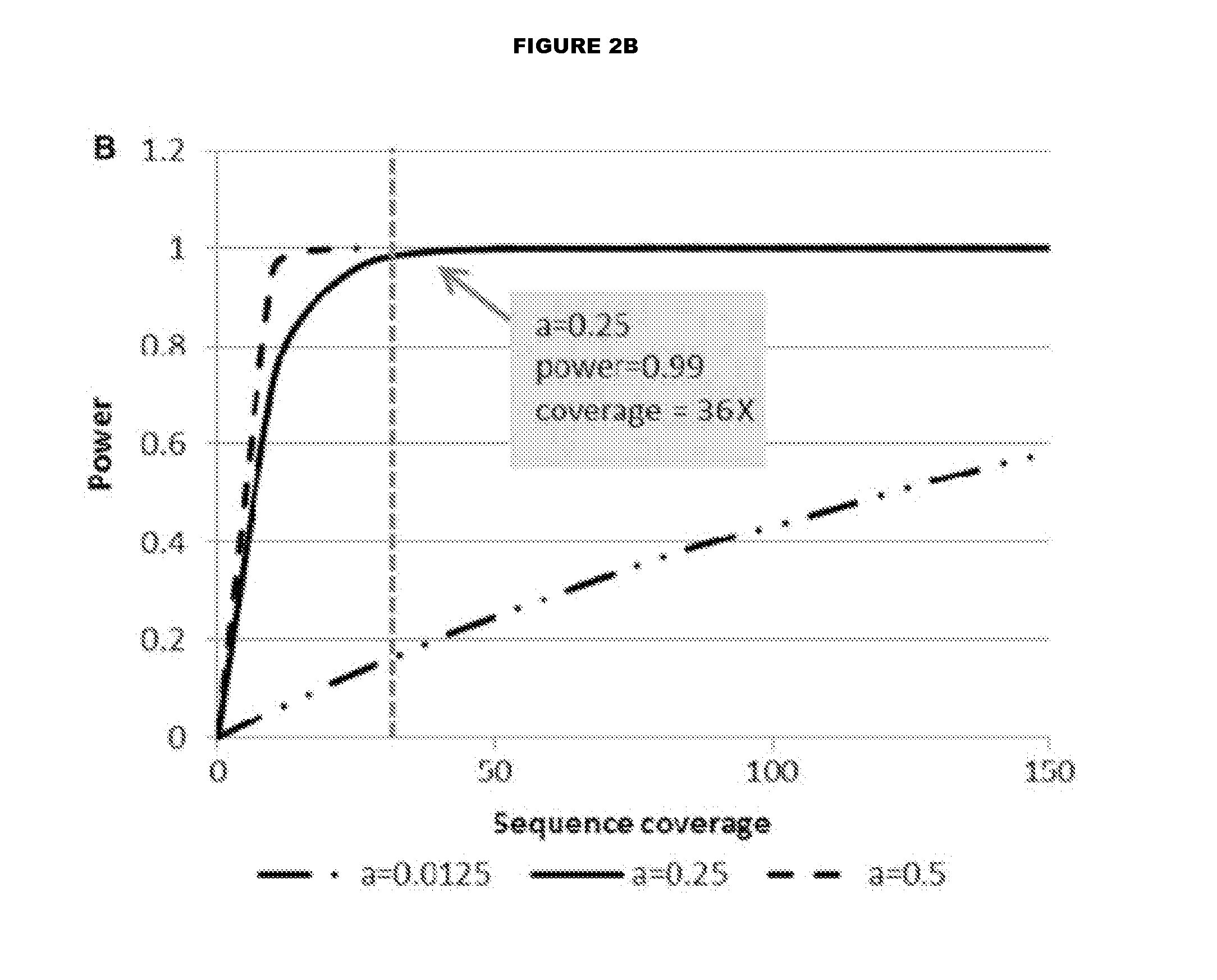Long insert-based whole genome sequencing
a whole genome and insert technology, applied in the field of systems and methods of sequencing biological molecules, can solve the problems of inability to pursue a viable sequencing approach, increased cost of whole genome sequencing (wgs), and inability to achieve the effect of sequencing
- Summary
- Abstract
- Description
- Claims
- Application Information
AI Technical Summary
Benefits of technology
Problems solved by technology
Method used
Image
Examples
example 1
Analysis of LI-WGS Library to Detect CNV's and Translocations
Modeling the Relationship Between Physical Coverage and Insert Size
[0063]To evaluate the relationship between insert size and physical coverage, we outlined a model for determining physical coverage. Physical coverage can be calculated by using the following equation (5):
C=N(2L+I)G
[0064]where C=physical coverage
[0065]N=number of aligned reads
[0066]L=read length (a multiplier of 2 is used for paired end (PE) sequencing)
[0067]G=size of human genome
[0068]I=inter-read base pair (bp) distance for PE sequencing such that the insert size equals 2L+I
[0069]The above equation can be condensed to the following:
C=2KL+KI [0070]where
K=NG
[0071]Since the approximate number of aligned reads is typically consistent across human genomes for a given aligner and the size of the human genome does not change, we treat K as a constant value. Physical coverage increases as the distance between reads increases.
[0072]Power analyses wer...
example 2
Modified Protocol for Generation of LI-WGS Library
[0132]Long Insert Library Preparation with KAPA Library Kits
[0133]Note: this protocol is based off the KAPA HTP Library Preparation Kit for Illumina Platforms, v2.11, which is hereby incorporated by reference in its entirety. Read this protocol first for important prep details that may have been omitted below.
Reagents
[0134]KAPA HiFi Library Amplification Kit, standard prep (50 Rxn-KAPA Cat#KK2611)
[0135]Agencourt AMPure XP Beads (60 mL—Beckman Coulter Cat#A63881)
[0136]Molecular Grade 100% EtOH
[0137]Molecular Grade H2O
[0138]TEIowE: 10 mM TrisHCl pH8.0, 0.1 mM EDTA, pH8.0 (Fisher Cat#50843207)
[0139]Covaris microTube sonication tubes—individual (Covaris Cat#520045) or 96 well plate (Covaris Cat#520078)
[0140]Lo-Bind 1.5 ml Eppendorf Tubes (VWR Cat#80077-230)
[0141]UltraPure Agarose (Invitrogen Cat#16500-500)
[0142]TAE 50× buffer (VWR Cat#BP1332-20)
[0143]Gel Star (Lonza Cat#50535)
[0144]Track-It 1 kb Plus DNA Ladder (Invitrogen Cat#10488-085)...
PUM
| Property | Measurement | Unit |
|---|---|---|
| volume | aaaaa | aaaaa |
| temperature | aaaaa | aaaaa |
| concentration | aaaaa | aaaaa |
Abstract
Description
Claims
Application Information
 Login to View More
Login to View More - R&D
- Intellectual Property
- Life Sciences
- Materials
- Tech Scout
- Unparalleled Data Quality
- Higher Quality Content
- 60% Fewer Hallucinations
Browse by: Latest US Patents, China's latest patents, Technical Efficacy Thesaurus, Application Domain, Technology Topic, Popular Technical Reports.
© 2025 PatSnap. All rights reserved.Legal|Privacy policy|Modern Slavery Act Transparency Statement|Sitemap|About US| Contact US: help@patsnap.com



